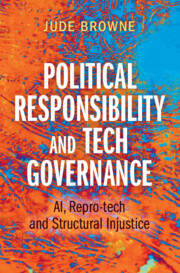Book contents
- Political Responsibility & Tech Governance
- Political Responsibility & Tech Governance
- Copyright page
- Dedication
- Epigraph
- Contents
- Preface
- Acknowledgements
- Introduction
- Chapter 1 The Problem of Structural Injustice
- Chapter 2 Artificial Intelligence and Ground Truth
- Chapter 3 Repro-tech and the Genetic Supermarket
- Chapter 4 Putting the Public into the Public Body
- Chapter 5 Conclusion
- Appendix Legal, Moral and Structural Actions, Injustices and Responsibilities
- References
- Index
Chapter 4 - Putting the Public into the Public Body
Published online by Cambridge University Press: 21 February 2025
- Political Responsibility & Tech Governance
- Political Responsibility & Tech Governance
- Copyright page
- Dedication
- Epigraph
- Contents
- Preface
- Acknowledgements
- Introduction
- Chapter 1 The Problem of Structural Injustice
- Chapter 2 Artificial Intelligence and Ground Truth
- Chapter 3 Repro-tech and the Genetic Supermarket
- Chapter 4 Putting the Public into the Public Body
- Chapter 5 Conclusion
- Appendix Legal, Moral and Structural Actions, Injustices and Responsibilities
- References
- Index
Summary
Here I bring together the arguments from the previous chapters of the book. My reading of Young’s work on structural injustice leads us to an uncomfortable political realisation. The usual tools deployed for addressing social harms and injustices – the tracing of liability in contextual moral or legal terms – are not useful for structural injustice, which is much more complex and amorphous in shape, not least in the context of AI and Repro-tech. Even though no simple political solution is apparent, I argue that one essential approach is to focus specifically on the question of whose interests are at play in the governance of transformative technologies as they operate in the background conditions of structural injustice. Thinking back to the arguments made in Chapter 3 about the functioning of regulators, I argue that the macro-level coordinating powers of a state can be redeployed to address background conditions of structural injustice through the direct reweighting of private and public interest within the mechanisms of governance itself. This is an alternative to current attempts in the context of tech governance to deploy a politics grounded in tracing fault or leaving structural patterns outside of political focus altogether. I advocate for a radical reshaping of large-scale regulatory public body landscapes in which a new form of lay-centric governance can be incorporated to deliver the sorts of decisions that a state defined by its current relationship with tech industries cannot.
- Type
- Chapter
- Information
- Political Responsibility and Tech GovernanceAI, Repro-tech and Structural Injustice, pp. 119 - 153Publisher: Cambridge University PressPrint publication year: 2025

